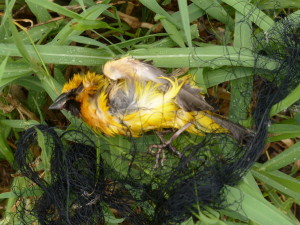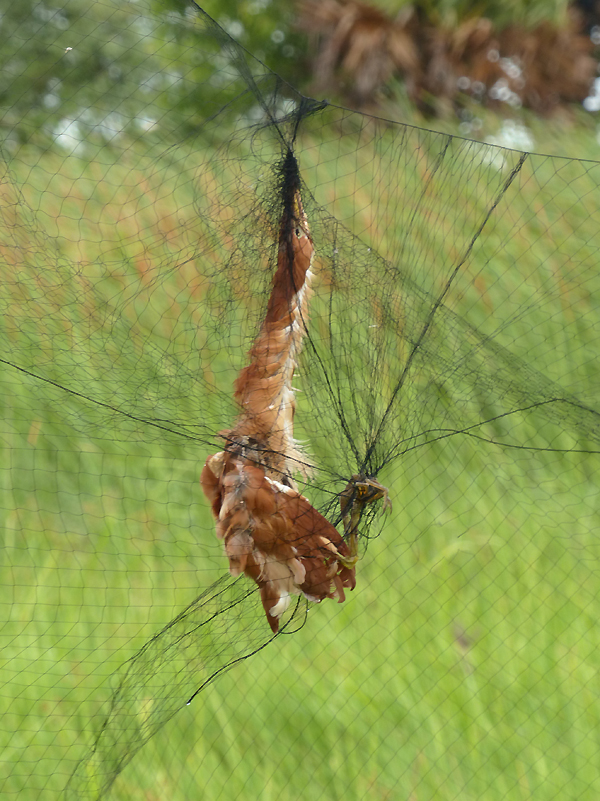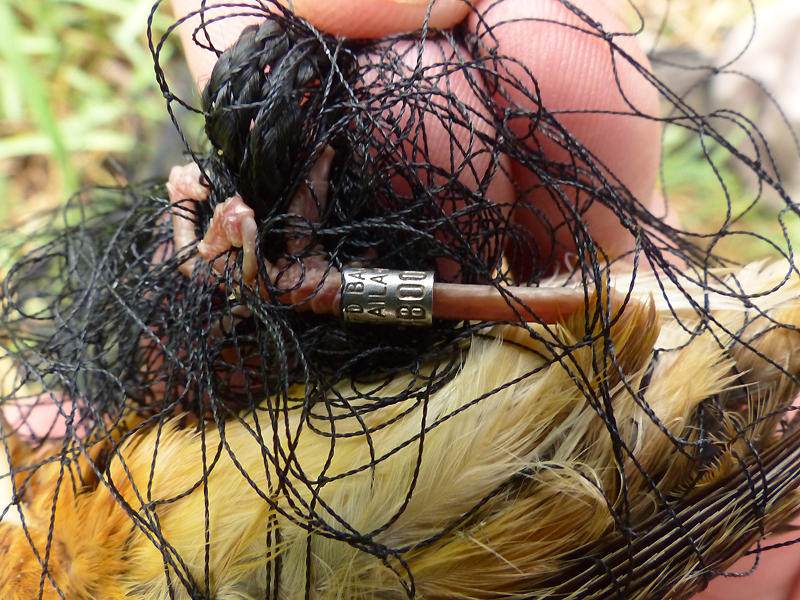
A couple of days ago on 20th May I was birding in the rice fields near Petchaburi, enjoying the spectacle of Weavers nesting. Baya Weaver colonies seem to be in every small tree, their complicated nests apparently in a constant state of construction, and plenty of small colonies of Asian Golden Weaver are in beds of Typha along drainage ditches. Added to this are less frequent colonies of Streaked Weaver in emergent vegetation and all together there is quite an entertaining level of activity to watch, making for a lot of photo opportunities. However, an extremely upsetting sight was about 20 Weavers (both Baya and Asian Golden) trapped, dead and dying in two mist nets erected next to a small rice field. Alongside a dead Cinnamon Bittern and a White-rumped Munia this tragic scene was not what visiting birders from Australia, who were with me, were hoping to see in Thailand.
When I discovered the mist nets it was shortly after a rain storm and all the birds trapped were extremely tangled in the nets and soaked; in fact all but one bird were already dead. In attempting to free the one bird still living we noticed that it had a ring on its leg – 3B00775, a female Asian Golden Weaver (I am told this bird was ringed at Laem Pak Bia Royal Project filter beds in August 2015) – which was extremely tangled in the nets and although we tried to free it, we could not, lacking the right equipment to cut it out.
The poor creature was barely conscious, extremely weak and died shortly after our efforts. Seeing such an awful scene was very frustrating, while I am not against hunting birds for food, I think that using a mist net is a dreadful and extremely destructive way to do it, having the potential to wipe out whole populations and may have been a major contributing factor in the massive decline in Yellow-breasted Bunting, while shooting a few birds for the pot can be done in a sustainable way. If the mist nets were to protect rice crops, they were failing to do that as many weavers were entering the field from areas not protected by the two short nets and a nearby local firing firecrackers into another rice field was having far more success in protecting his crop without killing birds.
Perhaps more frustrating is that there is no movement to prevent this type of practice around Thailand, which seems to me to becoming more widespread than I have previously seen. There is no conservation body involved in programs to educate locals or provide non-lethal alternatives for crop protection and no action is ever taken when this sort of thing is reported; occasionally nets are removed but always seem to reappear a short time later. Although Weavers are increasing in number, it only takes a few well-placed mist nets to completely wipe out a colony, meaning that they could easily quickly disappear if complacency sets in with those involved in conservation; it is better to protect birds while they are common than wait until they are so rare that they cannot be saved.
Also in this area many rice fields are being converted to high-input fish ponds and shrimp farms and most of these have lethal hooks suspended over the ponds to protect the stock. On these hooks it is common to see dead Bitterns, Asian Openbills, Jacanas and Egrets while at Pak Thale there are still many nets suspended over the sea where large numbers of shorebirds (including the critically endangered Spoon-billed Sandpiper) feed even though numerous people have reported these nets.
It is sad to see that even though Thailand has a lot more bird life than most countries in the region, these birds seem to be under increasing pressure from human activities.


 May 22nd, 2016
May 22nd, 2016  Nick
Nick 


 Posted in
Posted in  Tags:
Tags: 










